

Essay on Digital Citizenship
Students are often asked to write an essay on Digital Citizenship in their schools and colleges. And if you’re also looking for the same, we have created 100-word, 250-word, and 500-word essays on the topic.
Let’s take a look…
100 Words Essay on Digital Citizenship
What is digital citizenship.
Digital Citizenship is about using the internet and digital devices in a responsible and respectful manner. It’s like being a good citizen in the digital world. We should use technology in a way that doesn’t harm others and helps us learn and grow.
Why is Digital Citizenship Important?
Digital Citizenship is important because we spend a lot of time online. We learn, play, and talk with friends on the internet. Being a good digital citizen helps us use the internet safely and respectfully. It also helps us understand the impact of our actions online.
Elements of Digital Citizenship
There are several parts to being a good digital citizen. These include understanding digital etiquette, knowing how to stay safe online, respecting other people’s digital rights, and being aware of your digital footprint. All these elements help us use technology in a positive and responsible way.
Role of Schools in Digital Citizenship
Schools play a big role in teaching digital citizenship. They help students understand how to use technology responsibly. Schools also teach us about the dangers of the internet and how to avoid them. This helps us become better digital citizens.
In conclusion, digital citizenship is about being responsible and respectful online. It’s an important skill for everyone who uses the internet. By understanding digital citizenship, we can make the digital world a better place for everyone.
250 Words Essay on Digital Citizenship
Understanding digital citizenship.
Digital Citizenship is about how we behave online. It’s like being a good citizen in the real world, but in the digital world. We need to know how to use the internet and digital tools safely, respectfully, and responsibly.
Importance of Digital Citizenship
The digital world is a big part of our lives. We use it to learn, play, and talk with friends. But just like in the real world, there are rules we need to follow. Being a good digital citizen means following these rules. This will keep us safe and help us use the internet in a good way.
Aspects of Digital Citizenship
There are many parts to being a good digital citizen. One part is online safety. This means keeping personal information private and not sharing passwords. Another part is being respectful online. This means not bullying or hurting others with words or actions. A third part is using the internet responsibly. This means not stealing or copying other people’s work.
Schools play a big role in teaching digital citizenship. They can teach us about online safety, respect, and responsibility. They can also help us learn how to use digital tools in a good way. This will prepare us for a world where the internet is a big part of work and life.
Being a good digital citizen is important. It helps us stay safe, respect others, and use the internet in a good way. Schools can help us learn about digital citizenship. This will prepare us for a world that is more and more digital.
500 Words Essay on Digital Citizenship
Digital Citizenship is all about using the internet and digital devices in a responsible and respectful way. It’s like being a good citizen in the real world, but online! It includes understanding how to stay safe online, respecting others’ rights and privacy, and using digital tools in a positive way.
In today’s world, we spend a lot of time online. We use the internet for school, to talk to friends, and even to play games. But just like in the real world, there are rules we need to follow. These rules help to keep us safe and make sure we are being kind to others. That’s why understanding digital citizenship is so important.
Staying Safe Online
One of the key parts of digital citizenship is knowing how to stay safe online. This means not sharing personal information like your address or phone number with people you don’t know. It also means being careful about clicking on links or downloading things from the internet. These could be tricks to get your information or harm your computer.
Respecting Others
Just like in the real world, it’s important to respect others online. This means not saying mean things or sharing someone else’s information without their permission. It also means understanding that not everything you read online is true. So, before you share something, make sure it’s accurate.
Positive Use of Digital Tools
Digital citizenship also includes using digital tools in a positive way. This could mean using the internet to learn new things or to help others. It could also mean creating things like art or music using digital tools. The key is to use these tools to make the world a better place, not to harm others or break the rules.
In conclusion, digital citizenship is a very important part of our lives. It helps us to stay safe online, respect others, and use digital tools in a positive way. By understanding and following the rules of digital citizenship, we can make the internet a better place for everyone.
Remember, being a good digital citizen is like being a good citizen in the real world. It’s all about respecting others, staying safe, and using tools in a positive way. So, the next time you go online, think about how you can be a good digital citizen!
That’s it! I hope the essay helped you.
If you’re looking for more, here are essays on other interesting topics:
- Essay on Digital Addiction
- Essay on Digestive System
- Essay on Different Religions
Apart from these, you can look at all the essays by clicking here .
Happy studying!
Leave a Reply Cancel reply
Your email address will not be published. Required fields are marked *
Save my name, email, and website in this browser for the next time I comment.
- Weaver Magazine Vol.6
- Weaver Magazine Vol.5
- Weaver Magazine Vol.4
- Weaver Magazine Vol.3
- Weaver Magazine Vol.2
- Weaver Magazine Vol.1
- Institutes / Organizations
- Expert Advice
- Relationship
- Health & Fitness
- Entertainment
- Success Stories

Online Safety and Digital Citizenship
Forging a new frontier in peacebuilding and education.
Education experts and IT professionals discussed how digital technologies and the recent explosion of connectivity present risks of extremism, cyberbullying, threats to security, and privacy violations, especially for the world’s youth population and educators, at a Peacesharing 2021 Virtual Forum panel, “Online Safety and Digital Citizenship” on March 24.
Dr. Lisa Schirch, a Senior Research Fellow with the Tokyo-based Toda Peace Institute, shared how the institute’s Digital Peace Factory project uses a meme campaign to empower students to navigate digital spaces in a responsible and creative manner. A best practice and objective, she said, is to create “mindful engagement” of youth, including online discussions.
Dr. Maryam Lawal, a young professional at the World Bank’s Digital Development Global Practice in Washington D.C, drew from her expert knowledge to advise educators on how to maximize the benefits of the digital environment for children, yet understand the risk landscape. Her important insights in training youth and educators in digital technology deployment were well-received and grounded in World Bank expertise.
Explaining how online content and conduct influence the character of an individual’s digital identity, Oracle Academy’s HCH Senior Solution Engineer Ijeoma Nwoke described the imprint of online activity as a “digital tattoo,” while Nicole Punzi, a young scholar and Global Peace Foundation Organizational Development Associate shared her perspectives on how to prepare youth to identify, anticipate and react to online risks.
The panel provided links to research reports, publications, and project pages related to online best practices to international zoom participants. The two-day forum, “Forging a New Frontier in Peacebuilding and Education,” was organized by Global Peace Foundation and Co-operation Ireland, with more than 500 participants from 69 countries. The panel on online safety was moderated by Cat Lockman, International Director of Organizational Development at the Global Peace Foundation.
Take Action
Create a positive and impactful change in your area today.
Recent Posts
2024 international forum on one korea and 2024 korean dream grand march for a unified korea.

- Board And Staff
- Founder Isabelle Vladoiu
- Regional Directors
- All Courses
- Accreditation
- Digital Batch & Certification
- Professional Consultant
- Edu For Every Child
- Let Her Lead Program
- HRB Academy
- Nobody Left Behind
- Religious Freedom
- Rebuilding Ukraine Forum
- Disability Rights Summit 2022
- Youth Summit 2022
- Diplomacy And Human Rights2021
- Diplomacy And Human Rights2020
- Business Etiquette Secrets
- Human Rights Book
- Human Rights Coloring Book
- Blog Articles
- Volunteering
- Affiliate Program
- Religious Freedom Program
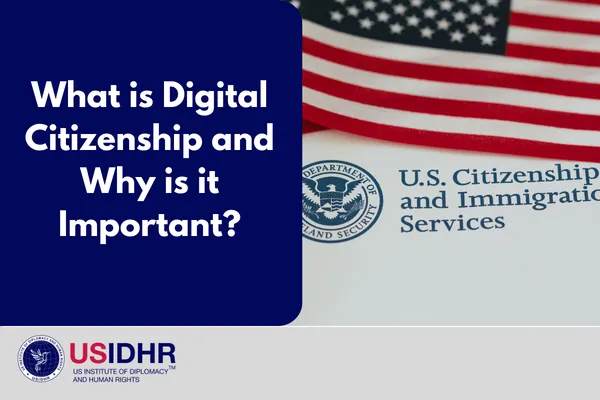
What is Digital Citizenship and Why is it Important?
May 26, 2022 by usidhr.org
The Covid-19 pandemic led to business and school closures which increased technology use for telework and online learning. Technology use is continuing to rise and it is increasingly important to be knowledgeable about how to use it correctly. Digital Citizenship is a way for business leaders, educators, governmental workers, and advocates to understand how we should use technology appropriately. Dr. Mike Ribble believes it’s “more than just a teaching tool, it is a way to prepare students for a society full of technology”[9]. With the correct use of the internet, students and adults can be more aware of human rights violations and how to protect themselves from fraud and disinformation. This article will cover the topics of technology, the importance of digital citizenship, and its implementation in society.
What is the impact of technology on youth?
Technology has had an enormous impact on a student’s learning. For example, it allowed them to have easy access to a larger amount of resources, it encouraged self-paced learning, it prepared them for careers in the tech industry, it improved their multitasking and problem-solving skills, and it can be used as a classroom tool to help students learn in new ways. With the rise of technology, children have started to use it from a very young age. According to the American Academy of Pediatrics, children between the ages of 8-10 years old spend 8 hours per day on technology, while teenagers spend more than 11 hours per day[1]. Many kids have computers and tablets at home before they start school, but elementary schools also have the option of online learning because it provides more independence and flexibility to a student’s learning. Recently, due to school closures, many students reverted to online learning and that led to an increase in technology use. According to Pew Research Center, 93% of parents with children from kindergarten to 12th grade said their children had online learning during the pandemic[13]. Among these parents, 62% report that the online learning was very successful[13]. While young people have increased their use of technology in schools, they also spend a lot of their time on social media. According to the American Academy of Child & Adolescent Psychiatry, 51% of teens between the ages of 13-17 use social media daily[15]. Social media platforms are often used as a news source by young people, so it is important to consider social media in Digital Citizenship Education. Concurrently, education also affects people's motivation to participate online. As students become more familiar with technology through their educational experiences, they are more likely to engage with digital platforms beyond just academic purposes. This increased engagement can lead to greater participation in online communities, discussions, and even activism, shaping not only their social interactions but also their role as informed digital citizens.
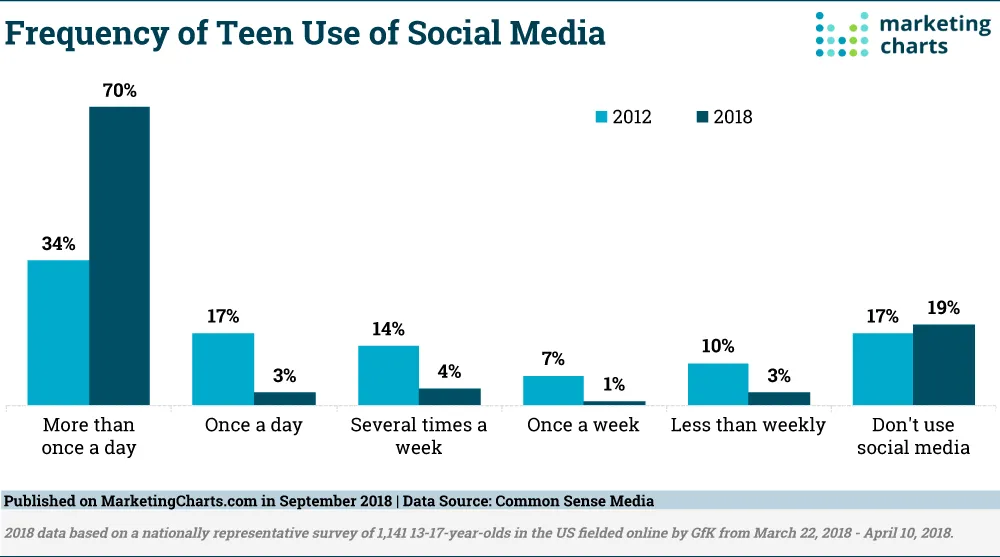
Source: Marketing Charts
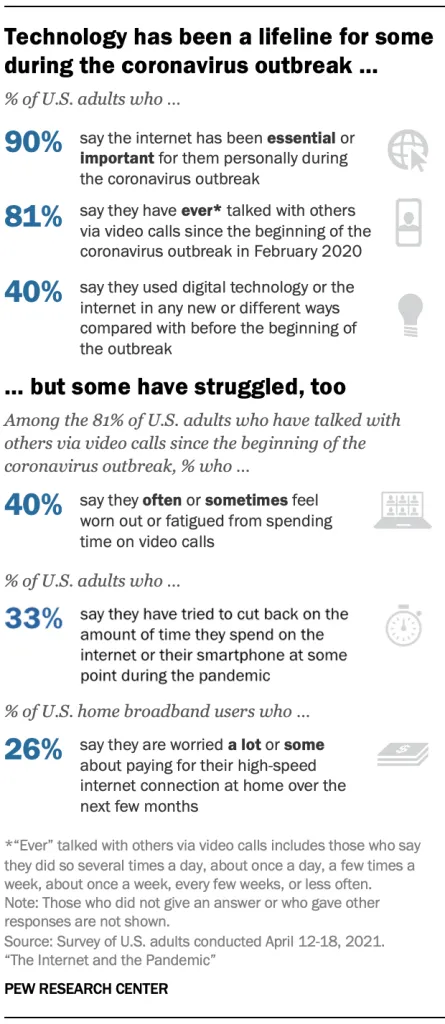
Source: Pew Research Center
Digital citizenship.
What is Digital Citizenship? Digital Citizenship teaches individuals how to engage and participate in responsible ways of using technology, in order to protect themselves from internet dangers and respect each other’s human rights. According to the Council of Europe, digital citizenship can be defined as:
“The competent and positive engagement with digital technologies (creating, working, sharing, socializing, investigating, playing, communicating, and learning); participating actively and responsibly (values, skills, attitudes, knowledge) in communities (local, national, global) at all levels (political, economic, social, cultural, and intercultural); being involved in a double process of lifelong learning (in formal, informal, and non-formal settings) and continuously defending human dignity”[4].
It is important to note that Digital Citizenship allows citizens to use technology and humanity in a thoughtful and empathetic manner. In 2017, the Alaska Department of Education and Early Development (DEED) organized the first “Alaska Digital Citizenship Week” where they encouraged schools to implement education technology. It was held again the following year and it became a very popular program throughout the state, thus encouraging teachers to be the main guide for students and their families into developing their safety awareness in the digital world[8].
Why is digital citizenship important?
In 2021, The Federal Trade Commission received 2.8 million fraud reports[10]. With the large number of news and media sources, there is a rise in fraud, misinformation, and disinformation. This is why it is important that people choose credible and valid sources. According to a Research led by Stanford History Education Group director Joel Breakstone, PhD, and co-authored by Wineburg, out of a sample of 3,446 students from 14 different states, less than 10% verified an online source’s credentials with a quick web search[11]. Fraudsters and sources spreading misinformation and disinformation take advantage of people without technological knowledge. Digital Citizenship Education is necessary because it protects others from being vulnerable to these issues.
Digital Citizenship Education
Digital Citizenship Education encourages individuals to use their knowledge, skills, and understanding to protect and promote human rights online, such as freedom, privacy, and security. In this way, people become more aware of internet safety. This is because digital citizenship education teaches us how to use the internet responsibly and safely, and how to protect ourselves from fraudsters and predators.
In Canada, 99% of students from 4th to 11th grade use the internet at home[9]. With the rise of technology users, this shows the importance of being knowledgeable about fraud, misinformation,
and disinformation. As a result, Digital Citizenship Education was implemented in Saskatchewan Schools, in order to support the appropriate and responsible online activity of Kindergarten to 12th Grade students. As seen with the evidence above, fraud, misinformation, and disinformation are on the rise and it is vital to be taught how to protect yourself from these common online problems.
Conclusion:
With the rise of technology use, Digital Citizenship Education is very important because it teaches citizens to use technology in order to engage respectfully online, to find reliable online sources and to avoid the violation of human rights. This can be achieved with schools and businesses implementing programs which will encourage people to expand their technological knowledge and promote human rights online.
Reference list:
[1] Strasburger, Victor C., Marjorie J. Hogan, Deborah Ann Mulligan, Nusheen Ameenuddin, Dimitri A. Christakis, Corinn Cross, Daniel B. Fagbuyi, et al. “Children, Adolescents, and the Media.” American Academy of Pediatrics. American Academy of Pediatrics, November 1, 2013. https://publications.aap.org/pediatrics/article/132/5/958/31699/Children-Adolescents-and-the-Media .
[2] “How Technology in the Classroom Can Impact Student Learning.” Top Hat, May 10, 2022. https://tophat.com/blog/how-does-technology-impact-student-learning/ .
[3] Western Governors University. “Impact of Technology on Kids Today and Tomorrow.” Western Governors University. Western Governors University, August 25, 2020. https://www.wgu.edu/blog/impact-technology-kids-today-tomorrow1910.html#close .
[4] “Digital Citizenship and Digital Citizenship Education.” Digital Citizenship Education (DCE). Accessed May 19, 2022.
[5] “Digital Citizenship in Education.” ISTE. Accessed May 19, 2022. https://www.iste.org/areas-of-focus/digital-citizenship .
[6] “The State of Privacy in Post-Snowden America.” Pew Research Center. Pew Research Center, August 17, 2020. https://www.pewresearch.org/fact-tank/2016/09/21/the-state-of-privacy-in-america/ .
[7] Schoology. “4 Benefits of Digital Citizenship for Internet Safety.” Schoology. Schoology, April 2, 2019. https://www.schoology.com/blog/4-benefits-digital-citizenship-internet-safety .
[8] Jordan, Sam. “Empowering Communities through Teaching Digital Citizenship.” Association of Alaska School Boards, November 18, 2018. https://aasb.org/empowering-communities-through-teaching-digital-citizenship/ .
[9] Couros, Alec, Hildebrandt, Katia. “Digital Citizenship Education in Saskatchewan Schools.” Accessed May 19, 2022. http://iamstronger.ca/userdata/files/244/DC%20Guide%20-%20ENGLISH%20WEB.pdf .
[10] Staff, the Premerger Notification Office, and This blog is a collaboration between CTO and DPIP staff and the AI Strategy team. “New Data Shows FTC Received 2.8 Million Fraud Reports from Consumers in 2021.” Federal Trade Commission, February 22, 2022. https://www.ftc.gov/news-events/news/press-releases/2022/02/new-data-shows-ftc-received-28-million-fraud-reports-consumers-2021-0 .
[11] Pappas, Stephanie. “Fighting Fake News in the Classroom.” Monitor on Psychology. American Psychological Association. Accessed May 19, 2022. https://www.apa.org/monitor/2022/01/career-fake-news .
[12] “Educational Researcher – Volume 50, Number 8, Nov 01, 2021.” Accessed May 19, 2022. https://journals.sagepub.com/toc/edr/50/8 .
[13] McClain, Colleen, Emily A. Vogels, Andrew Perrin, Stella Sechopoulos, and Lee Rainie. “The Internet and the Pandemic.” Pew Research Center: Internet, Science & Tech. Pew Research Center, April 28, 2022. https://www.pewresearch.org/internet/2021/09/01/the-internet-and-the-pandemic/ .
[14] “What Is Digital Citizenship?” Avast. Accessed May 20, 2022. https://blog.avast.com/what-is-digital-citizenship-avast .
[15] Aacap. Social Media and teens. Accessed May 23, 2022. https://www.aacap.org/AACAP/Families_and_Youth/Facts_for_Families/FFF-Guide/Social-Media-and-Teens-100.aspx .
Join One of Our Certificate Trainings:
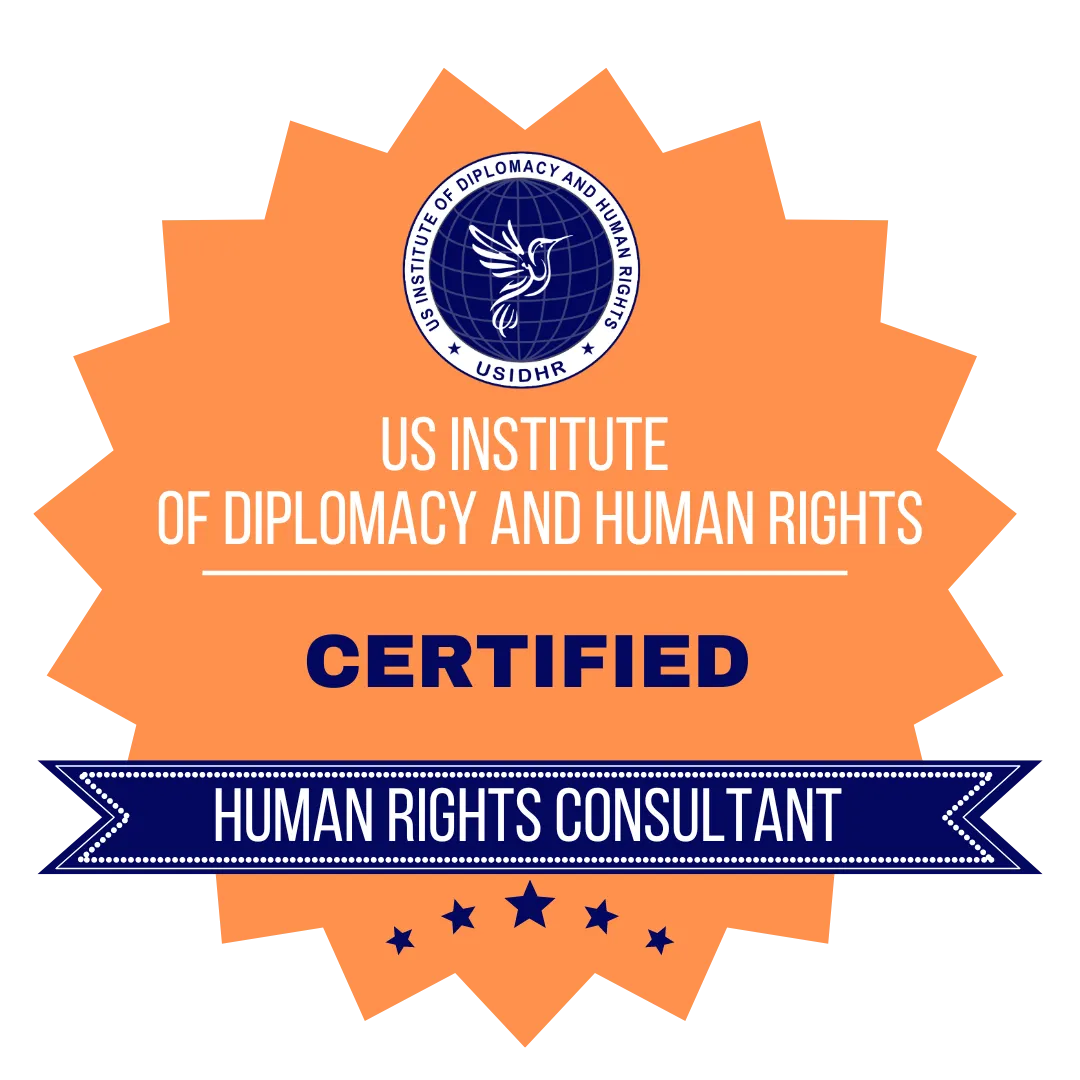
Human Rights Education Certification Training
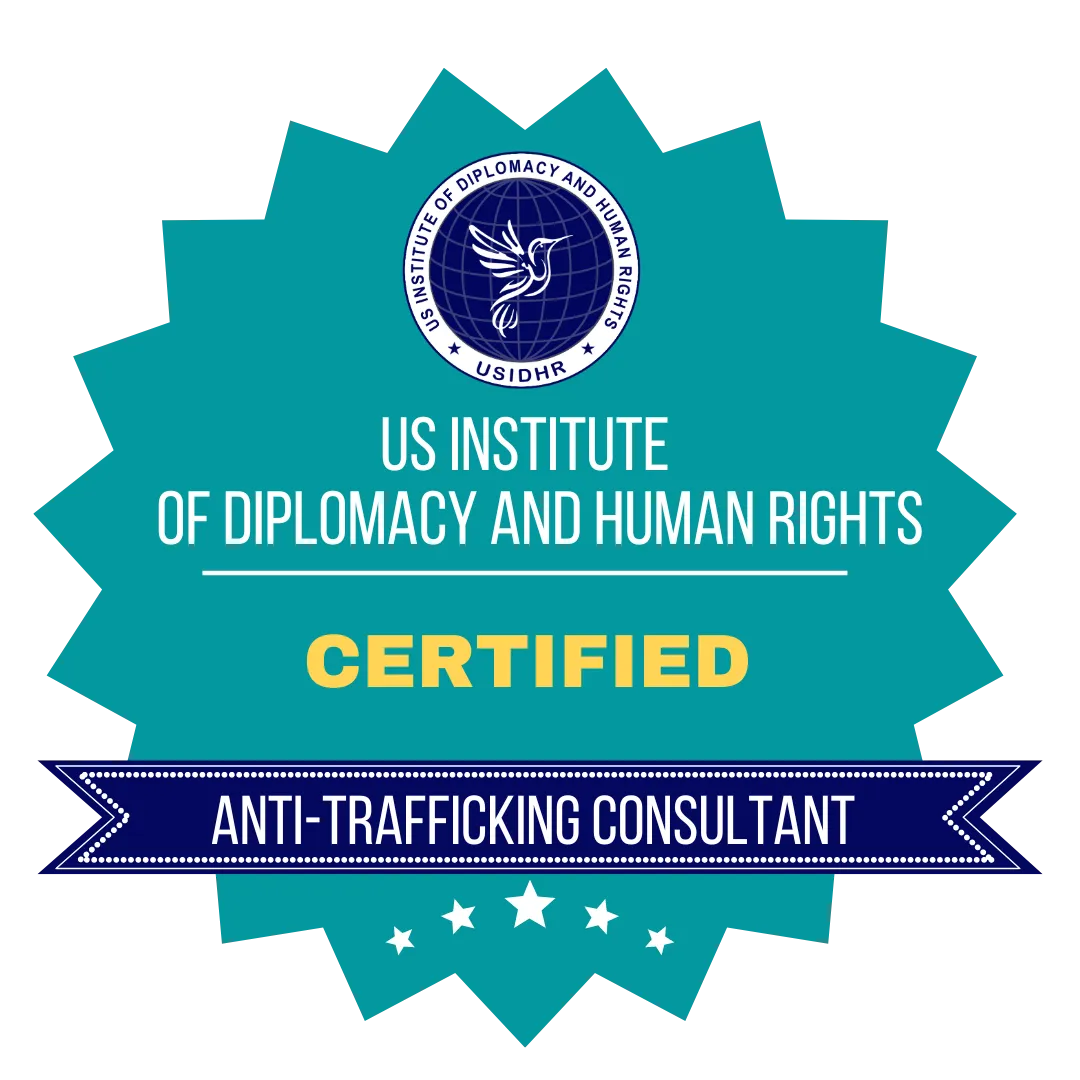
Human Trafficking Certification
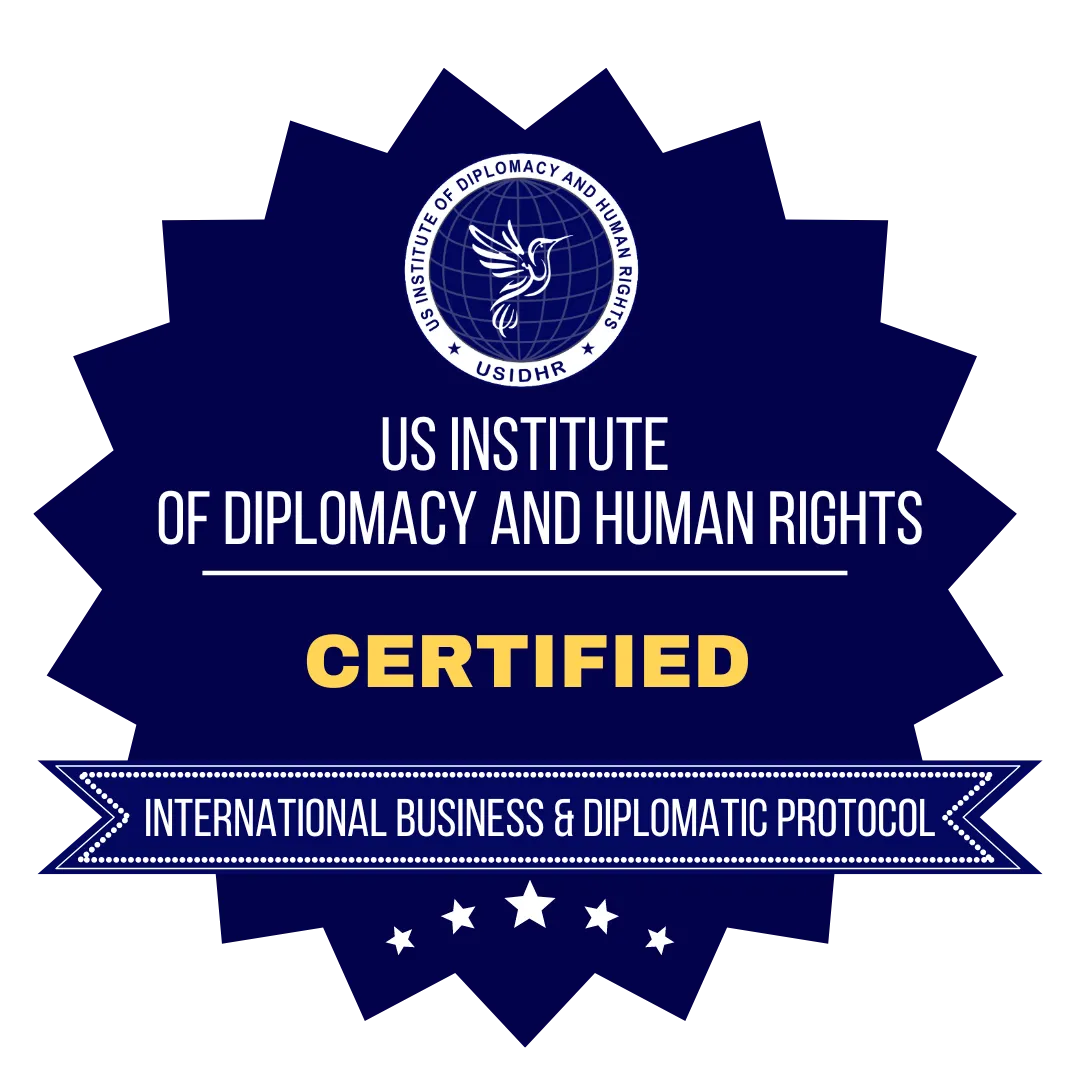
International Business and Diplomatic Protocol Certification
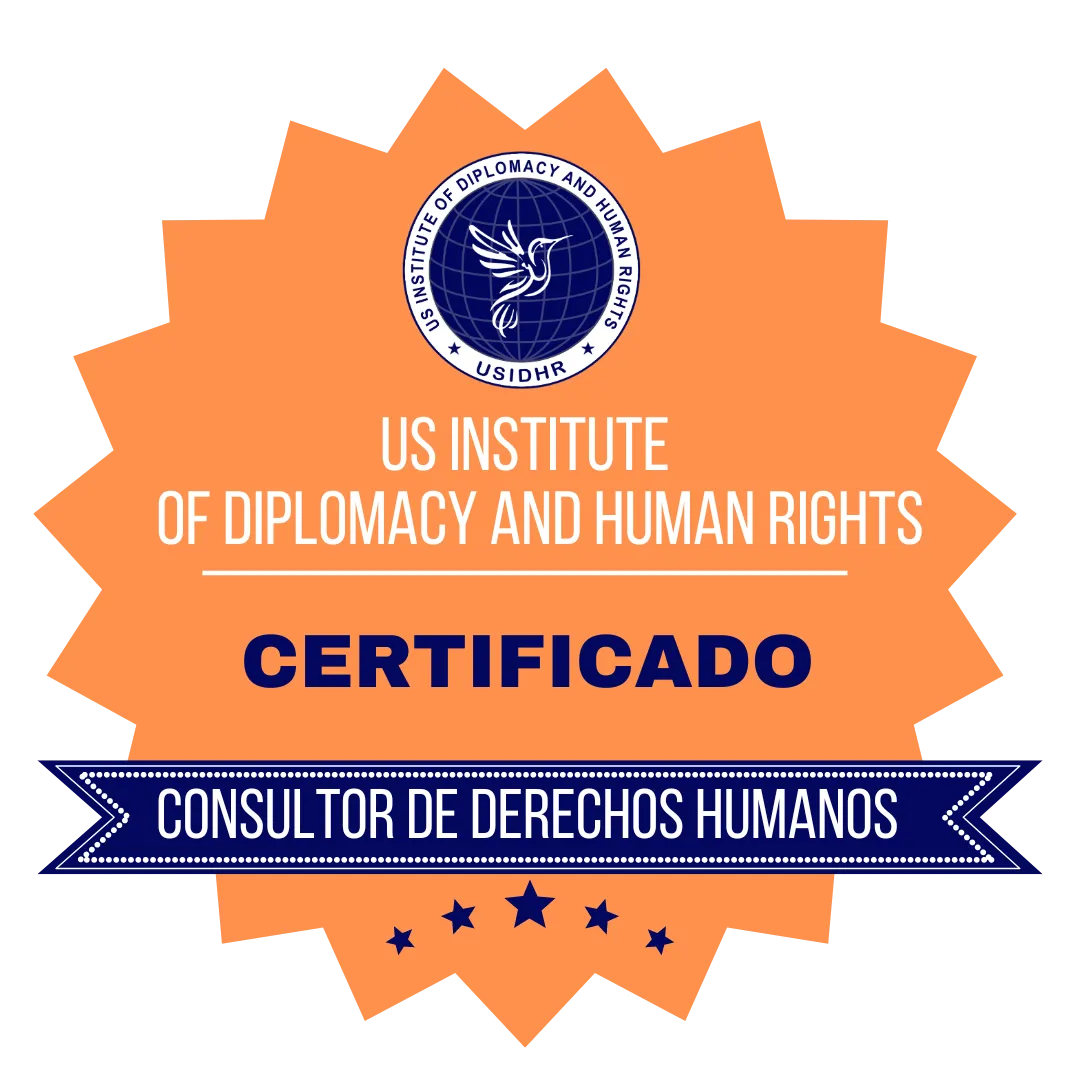
Capacitación En Derechos Humanos
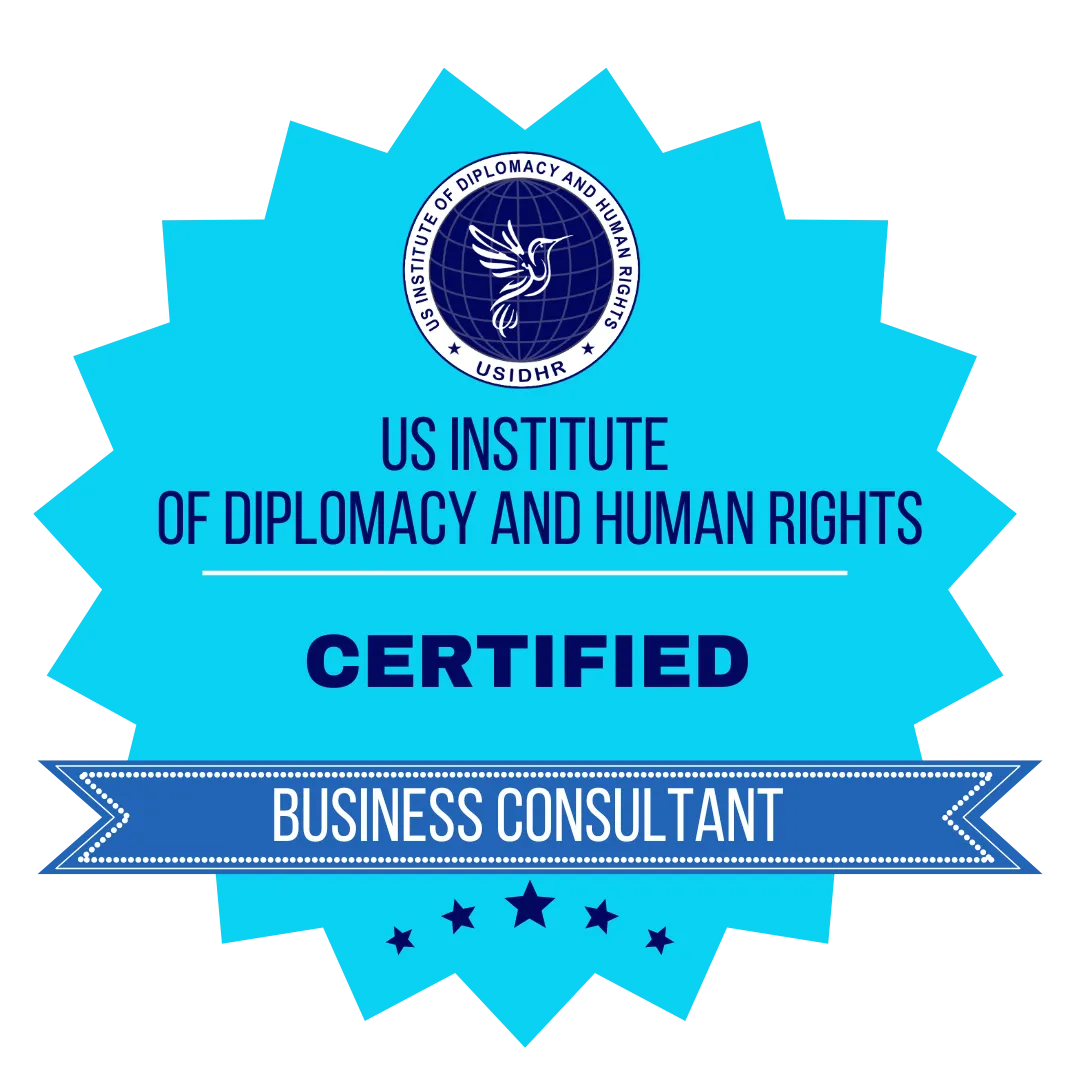
Business Consulting Certification Training
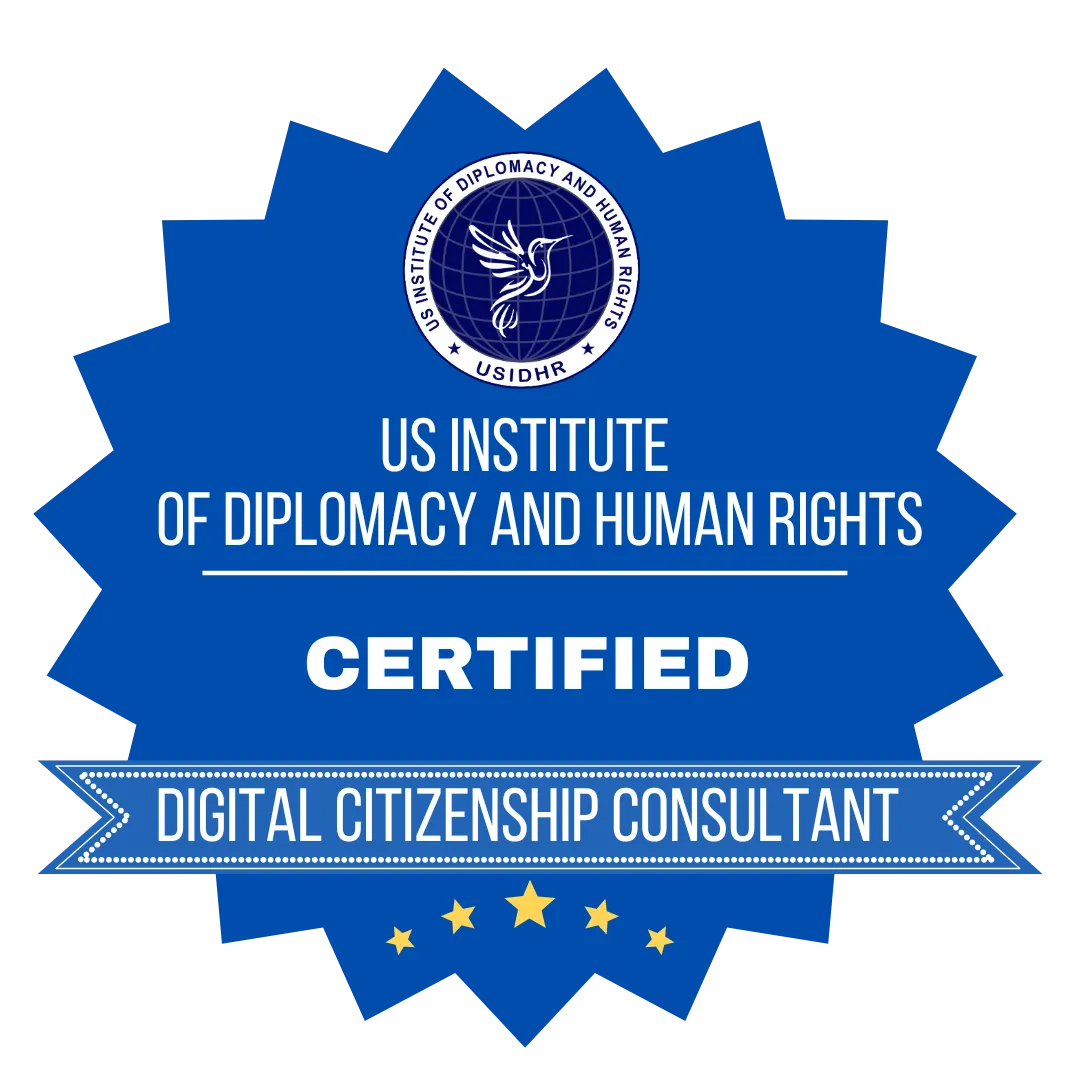
Digital Citizenship Certification
Other blogs you may like:.

What is meant by Open Diplomacy?
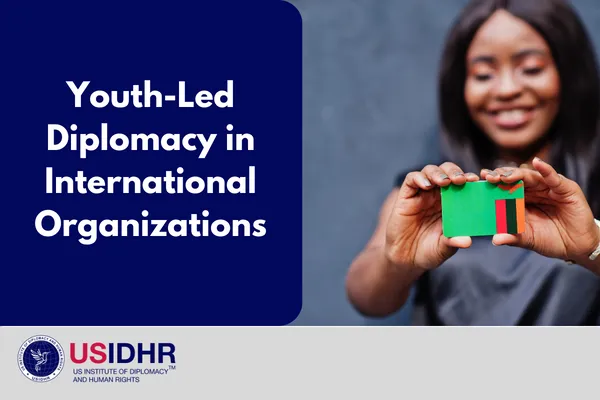
Youth-Led Diplomacy in International Organizations
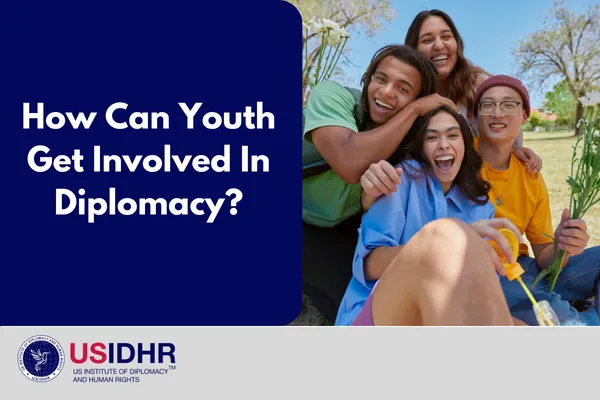
How Can Youth Get Involved In Diplomacy?
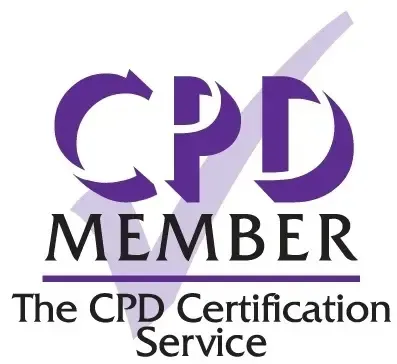
The US Institute of Diplomacy and Human Rights (USIDHR) is an International Continuing Professional Development (CPD) Accredited Organization. Accredited CPD training means the learning activity has reached the required Continuing Professional Development standards and benchmarks. The learning value has been scrutinized to ensure integrity and quality. The CPD Certification Service provides recognized independent CPD accreditation compatible with global CPD requirements

US Institute Of Diplomacy And Human Rights
1250 Connecticut Ave NW Ste 700, Washington, DC 20036
Email support at: [email protected]
USA Phone: +1(202)-505-7707

- My Storyboards
Digital Citizenship and Internet Safety: Essentials for Responsible Online Behavior
Understanding digital citizenship, what is digital citizenship.
A comprehensive digital citizenship definition refers to the responsible and ethical use of technology by individuals. It encompasses behaviors that contribute to a safe, respectful, and productive online environment. In today’s interconnected world, where digital interactions are ubiquitous, understanding media education is crucial. What does digital citizenship mean? It includes knowing how to navigate the internet safely, recognizing and combating cyberbullying, and maintaining privacy and security. Embracing this role means being aware of one’s online presence and making thoughtful decisions that affect both oneself and others.
The Importance of Internet Safety
Internet safety for kids is a fundamental aspect of media education, especially for children and students. The online world is vast and offers numerous opportunities for learning and connecting, but it also poses risks such as exposure to inappropriate content, cyberbullying, and privacy breaches. Teaching internet safety for students helps protect young users from these dangers and empowers them to make informed decisions. It also fosters a sense of responsibility and respect towards others in the digital space, laying the groundwork for positive and constructive online behavior.
This generation of students has more exposure to the web and are more technically adept in navigating it than their predecessors. Early (and often unsupervised) access to the internet means that while they're great at finding obscure information and completing projects, they might not know how to stay safe.
It's important to discuss internet safety with students at the beginning of the year, or when you're beginning your first unit that involves any sort of digital literacy element. It's also important to remind students about digital citizenship as it extends beyond an individual staying safe.
In a time where students are spending more time on the computer both during school and at home, it's important for them to understand the rules of internet safety and media education. Not only will these protect them and their information, it will also protect their classmates and friends from misunderstandings or potentially dangerous situations.
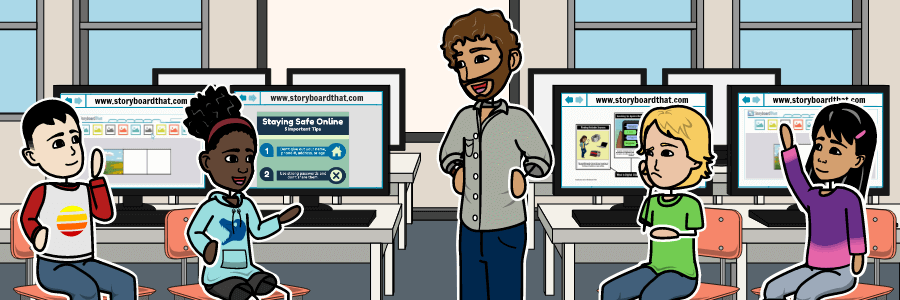
Core Principles of Digital Citizenship
Internet safety vs. digital citizenship.
While these topics are connected, they are two separate ideas. While digital citizenship curriculum is focused on how behavior and actions spread and affect others on the web and the ways students should conduct themselves as good citizens of this digital world, internet safety includes concrete do's and don'ts to protect students. Where these two concepts meet is in the spread of information, whether it's the student's own personal information or personal information about a classmate. Educators play a vital role in promoting media education for students, guiding them to become responsible and ethical digital citizens.
Internet Safety
Internet safety is crucial at every age, and it's good to start instructing students about the importance of staying safe online while they're young. In a digital age, it's important for them to understand that things don't just disappear, and they should be conscious about the information they share. Additionally, the rise of sites that allow you to compile information (like age, names, interests, potential triggers, and more) make it easier for those with bad intentions to infiltrate seemingly safe spaces. Students should be reminded that while not everyone on the internet is out to harm them, they should still be careful who they trust, just like they would in reality.
- Do use strong passwords and keep it secret. Don't make it easy for people to access your accounts!
- Do use nicknames or screen names that don't contain personal information like your name or birthday.
- Do talk to a trusted parent or guardian about the websites you are using.
- Do tell a trusted adult if you are being cyberbullied or witness cyberbullying.
- Do say no or leave a conversation if you feel uncomfortable and tell a trusted adult about it.
- Do log off of websites when you are finished with them, especially on shared or public computers.
- Don't give out your name, age, or location. A combination of these things can make it easy for someone to find you in real life.
- Don't publicize mental health diagnoses that people can use to purposely trigger or manipulate you.
- Don't provide information about other people's names, location, etc.
- Don't participate in memes that ask for your first car, mother's maiden name, first pet, or other information that is often used in password recovery.
- Don't talk to strangers or people you don't know.
- Don't put anything online that you wouldn't want someone to find.
- Don't click on links from people you don't know. If something looks suspicious and seems like it's from someone you know, ask a trusted adult before clicking!
- Don't venture onto sites you know you shouldn't be on. Websites have restrictions for a reason!
- Don't agree to physically meet someone online. Tell a trusted adult if someone asks you to do this.
Digital Citizenship and Safety
Digital citizenship curriculum is all about being a good citizen online, the same way you would in your school or community. Kids can practice this while they're playing online multiplayer games, chatting on social media, doing research or attending online class, or anything else they may do online! Technology can do powerful things, and it's important that learners are able to harness that power while still being empathetic citizens of the world. Sharing safety rules with students helps them understand how to protect themselves online and contribute to a positive digital community.

Helpful Tips
- Speak up if you or someone else is being cyberbullied. Standing up for the person is the first step toward making sure others do the right thing, and a trusted adult should always be contacted.
- Understand why sites have rules about users under 13! This is to protect you and your information, ensures you aren't seeing inappropriate content, and keeps you from being advertised to.
- Check sources on news and information! Learning what a reliable source is and how to combat clickbait and misinformation will allow you to be able to better form an opinion on current events and use accurate research in papers.
- Learn about copyright and creative commons. It's important to source any images or information you use in projects, but it's also important to remember that not every image should be used freely.
- Interact with others the way you want to be treated. Be kind and thoughtful while speaking to or posting about others online. Make sure that others can't misinterpret your words or aren't hurt by them.
- Think before you post! If you wouldn't want friends, parents, teachers, or future employers to see it, keep it to yourself. Your digital footprint is permanent, whether you think so or not.
Digital Citizenship for Kids and Students
media education for kids can be tailored to various age groups to help them navigate the online world responsibly. For younger children, the focus might be on basic computer safety for kids, such as recognizing safe websites and understanding the importance of not sharing personal information. For older kids, discussions can expand to include more complex issues like managing one’s digital footprint, understanding the implications of social media use, and dealing with cyberbullying. Educators and parents should use age-appropriate strategies to instill these values.

Integrating Digital Citizenship and Internet Safety in the Classroom
One of the great challenges in teaching kids how to be safe is to safely provide them with scenarios and situations that will require wise decision making skills . It's easy to provide a list or a lecture, but teachers need to make sure that learners fully understand what it means to be safe online or how to handle tough situations before they encounter them.
Posters and Infographics
Posters and infographics can be displayed and are handy tools for conveying information in a clear and concise manner. They can be created by both teachers and students, so can be used as informational handouts or research projects.
Posters can be created to outline rules and tricks for digital safety, do's and don'ts of internet safety, or PSAs . We have an ever growing gallery of templates to choose from so that children and teachers can make the perfect poster. Infographics can display research learners did on online safety, advice on creating a strong password, or even ways to stay safe. The completed projects can be printed and hung up at school to spread awareness!
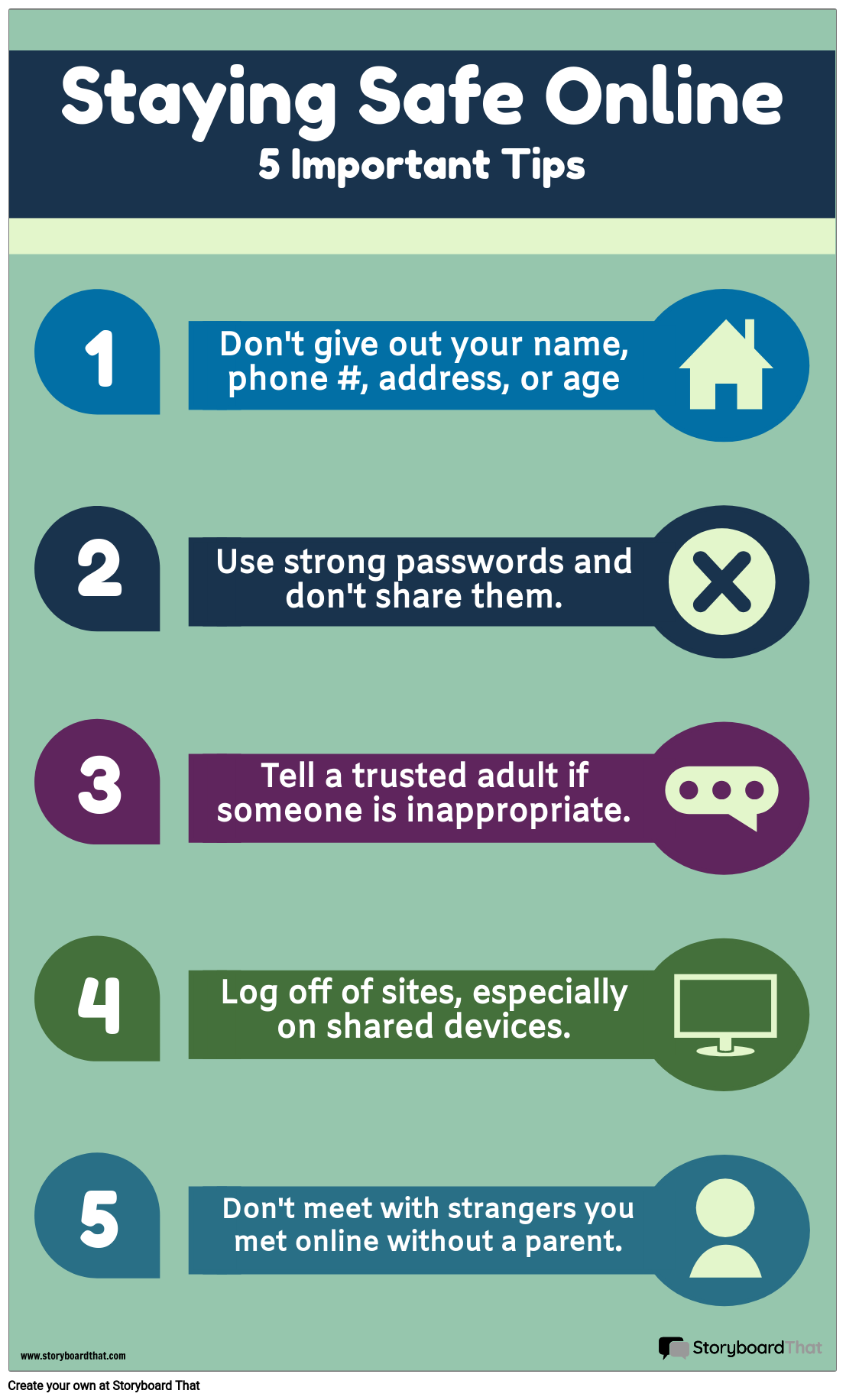
Storyboard That is perfect for creating social stories. Illustrating internet safety guidelines or a situation that students might encounter helps kids more fully comprehend how their actions can help or harm. Teachers can approach this type of activity a few different ways. Ideas for scenarios can include someone leaving their account logged in on a shared device, sexting, cyberbullying, or checking sources.
One way is to make a completed scenario and walk students through the example. Then ask learners the following questions: What is happening? How did the student respond? Was what they did wrong or right? Why? This can be done as a class discussion or kids can respond individually in a short writing assignment.
Another idea is to make a scenario and leave cells blank for kids to fill in. This allows them to practice critical thinking and respond to the scenario as if they were involved. Teachers may choose to display student work afterward and hold a discussion with the class if there are any differences in answers (both right and wrong).
The next step would be to have children make their own scenario! They should illustrate a potential situation and demonstrate how to properly respond to it in order to stay safe. Teachers can ask learners to present their scenarios and explain their choices in an activity that combines creativity and presentation skills.
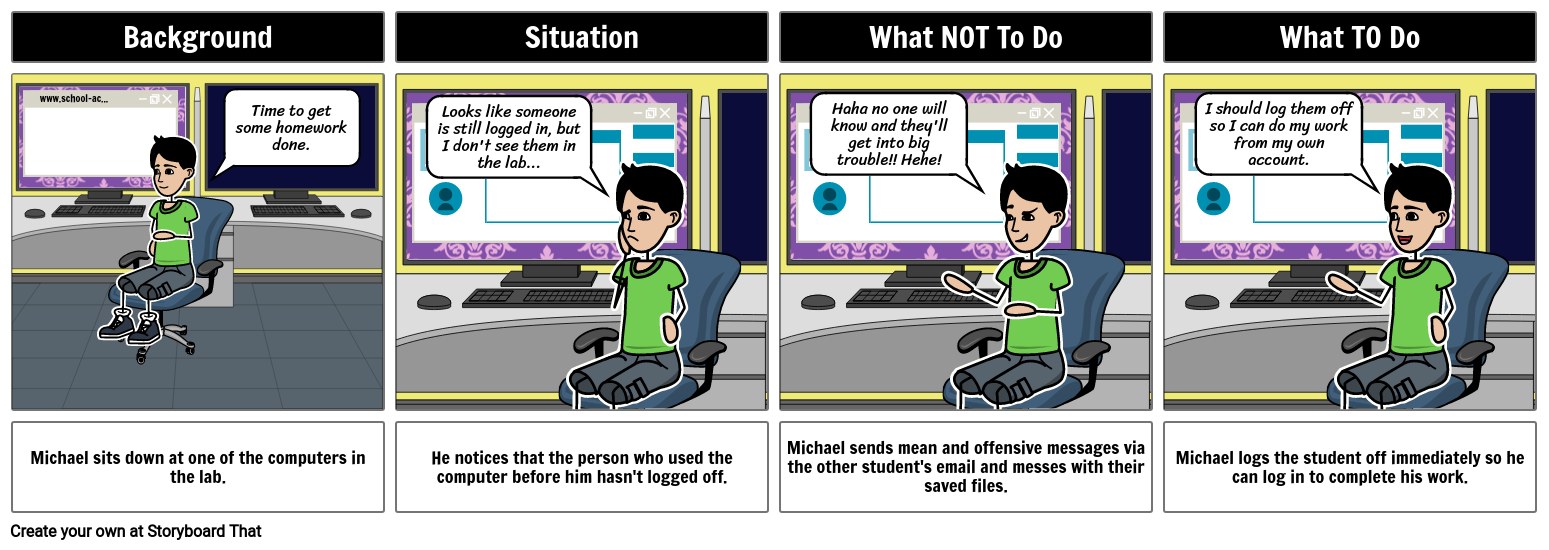
Set kids up for success by giving them the tools they need to stay safe and kind. As things move further and further online, it's important to make sure they know what to do and what not to do. There's no need for scare tactics like the ones used in the 90s and 2000s, but students should be knowledgeable about the dangers of sharing information and how to protect themselves. Using Storyboard That makes it fun and easy!
Promoting Safe Internet Practices
Internet safety tips for kids.
- Use Strong Passwords: Encourage kids to use passwords that are hard to guess and remind them not to share their passwords with anyone except their parents.
- Privacy Settings: Teach children how to adjust privacy settings on websites and apps to control who can see their information.
- Recognize Safe Websites: Show kids how to identify secure websites by looking for “https” in the URL and a padlock symbol.
- Don't Share Personal Information: Emphasize the importance of not sharing personal details like their full name, address, phone number, or school name online.
- Ask for Help: Encourage kids to talk to a trusted adult if they encounter something online that makes them uncomfortable.
Cyber Safety for Students
Teaching cyber safety for kids includes educating them on how to avoid cyberbullying, recognize online threats, and use digital tools responsibly.
- Handle Cyberbullying: Educate kids on what constitutes cyberbullying and provide strategies for dealing with it, such as blocking and reporting offenders.
- Secure Personal Data: Teach students to regularly update their passwords, use secure connections, and be cautious about the information they share online.
- Navigate Social Media Responsibly: Guide learners on the responsible use of social media, including how to manage their privacy settings and the potential long-term impacts of their online actions.
Educational Strategies for Digital Citizenship
Teaching digital safety.
Ensuring digital safety for kids is a priority, as it equips them with the knowledge and skills to protect their personal information and interact safely online.
Effective methods for teaching digital safety and citizenship include:
- Lesson Plans: Develop comprehensive lesson plans that cover various aspects of digital safety and citizenship.
- Interactive Modules: Use interactive modules and simulations to provide hands-on learning experiences.
- Classroom Activities: Engage students in activities that promote digital literacy, such as role-playing scenarios to practice safe online behavior.
Digital Citizenship in Curriculum
Integrating media education topics into the school curriculum ensures that children gain a well-rounded understanding of both technological and ethical aspects of digital interactions. This can be achieved by:
- Embedding Concepts: Include topics in existing subjects, such as social studies, language arts, and IT classes.
- Project-Based Learning: Encourage project-based learning where kids can explore real-world issues related to digital citizenship.
- Cross-Curricular Projects: Implement cross-curricular projects that allow students to see the relevance of media education across various disciplines.
Resources for Enhancing Digital Literacy
Incorporating digital literacy safety into lessons ensures that learners not only use technology effectively but also safely.
Digital Citizenship Resources
Sharing safety tips with students helps them understand how to protect themselves online and contribute to a positive digital community.
Here are some valuable resources for educators to teach safety guidelines for the internet:
- Common Sense Education: Offers free K-12 lesson plans and interactive activities.
- Google’s Be Internet Awesome: Provides a comprehensive curriculum and games designed to teach kids the fundamentals of digital safety and citizenship.
- NetSmartz: An educational program that offers age-appropriate resources to help teach children how to be safe online.
Activities and Games for Learning
Interactive games and activities can make media education fun and engaging:
- Interland by Google: A free, web-based game that teaches kids about internet safety.
- Digital Passport by Common Sense Education: Games and activities for grades 3-5 that teach critical digital skills.
- CyberSmart!: An interactive program that offers a range of activities designed to help students understand and practice safe online behavior.
By fostering an understanding of digital citizenship and promoting safe internet practices, we can help students navigate the web responsibly and ethically.
Related Activities
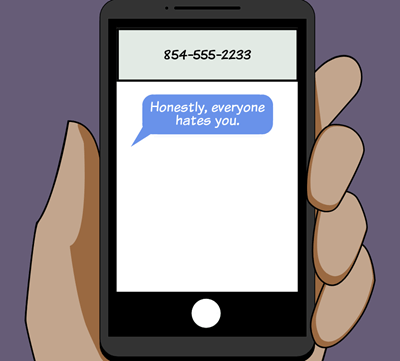
How To Promote Digital Citizenship: Foster Responsible Digital Behavior By Teaching Students About Rights, Responsibilities, Privacy, And Online Etiquette
Introduce digital rights and responsibilities.
Teach students about their digital rights, such as privacy, freedom of expression, and responsible online behavior. Help them understand their responsibilities in using technology and participating in online communities.
Explore Online Privacy and Security
Educate students on the importance of protecting their personal information online. Teach them strategies to safeguard privacy, such as using strong passwords, being cautious with sharing personal details, and understanding the risks of oversharing.
Teach Online Etiquette and Respectful Communication
Guide students on practicing online etiquette and respectful communication. Discuss topics like netiquette, appropriate language, and being mindful of the impact of their words and actions on others in digital spaces.
Address Cyberbullying and Digital Harassment
Discuss the consequences of cyberbullying and digital harassment, and empower students to stand against such behavior. Teach them how to recognize, respond to, and report instances of cyberbullying, promoting a safe and inclusive online environment.
Develop Critical Thinking and Media Literacy Skills
Equip students with critical thinking and media literacy skills to navigate the vast digital landscape. Teach them to evaluate information sources, identify misinformation or fake news, and become discerning consumers of online content.
Encourage Digital Well-being and Balance
Foster discussions on digital well-being and the importance of maintaining a healthy balance between online and offline activities. Teach students strategies for managing screen time, promoting digital self-care, and nurturing positive relationships both online and offline.
Frequently Asked Questions about Internet Safety and Digital Citizenship
What is the difference between internet safety and digital citizenship.
Internet Safety focuses on concrete measures to protect oneself online, while Digital Citizenship is about promoting responsible and ethical behavior in the digital world. Internet Safety deals with personal protection, while Digital Citizenship encompasses how one's actions and behavior affect others online.
Why is Internet Safety important for students?
Internet Safety is crucial for students of all ages because it teaches them how to protect themselves online. It emphasizes the importance of being cautious about personal information, interacting with strangers, and understanding the potential risks and consequences of online activities.
What are some Internet Safety do's and don'ts for students?
Internet Safety do's include using strong passwords, talking to a trusted adult about the websites they use, and reporting cyberbullying incidents. Don'ts include giving out personal information, participating in risky online challenges, and clicking on suspicious links from unknown sources.
How can Storyboard That be used to teach Internet Safety and Digital Citizenship?
Storyboard That is a versatile tool for teaching Internet Safety and Digital Citizenship. It can be used to create visuals, such as posters and infographics, that provide information and raise awareness. It can also be used to create interactive scenarios where students can practice decision-making and critical thinking skills in relation to online safety and responsible digital behavior.
Pricing for Schools & Districts
- 5 Teachers for One Year
- 1 Hour of Virtual PD
30 Day Money Back Guarantee • New Customers Only • Full Price After Introductory Offer • Access is for 1 Calendar Year
- 30 Day Money Back Guarantee
- New Customers Only
- Full Price After Introductory Offer
Introductory School Offer
30 Day Money Back Guarantee. New Customers Only. Full Price After Introductory Offer. Access is for 1 Calendar Year
Generating a Quote
This is usually pretty quick :)
Quote Sent!
Email Sent to
Digital Citizenship: Navigating the Online World Responsibly and Safely
- Category: Sociology , Information Science and Technology
- Topic: Digital Communication , Digital Era , Digital Literacy
Pages: 4 (1976 words)
- Downloads: -->
- Bhatt, A. (2018, June). How social media can change the world. TEDx Talks. Retrieved from https://www.youtube.com/watch?v=hDBWaTkMbXQ.
- Boitnott, J. (2015, July). Tech Is Changing the Way We Get Our News, and It's Not Stopping. Retrieved from https://www.inc.com/john-boitnott/tech-is-changing-the-way-we-get-our-news-and-it-s-not-stopping.html.
- Carreras, F. (2017, June). The Secret to Online Influence. TEDx Talks. Retrieved from https://www.youtube.com/watch?v=2FV_ONI8J0E.
- Casey, B. (2016). Why Digital Citizenship is Digital PBIS- and Why It Really Matters. AWSA. Retrieved from https://awsa.memberclicks.net/update-article--why-digital-citizenship-is-digital-pbis--and-why-it-really-matters.
- Fastenau, J. (2018, March). Under the Influence: The Power of Social Media Influencers. Retrieved from https://medium.com/crobox/under-the-influence-the-power-of-social-media-influencers-5192571083c3.
- Gleason, B. (2018). Digital Citizenship with Social Media: Participatory Practices of Teaching and Learning in Secondary Education. Journal of Educational Technology & Society.
- Krutka, D. (2017, November). DIGITAL CITIZENSHIP in the Curriculum: Educators can support strong visions of citizenship by teaching with and about social media. Education Leadership.
- Marrero, M. (2019, February). Inside the big business of being a social media influencer.
- ABC News. Retrieved from https://www.youtube.com/watch?v=5SOFSjlU0fM.
- Murchie, M. (2010, September). Does the internet improve communication? South China Morning Post.
- Patterson, M. (2015, September). Embracing the 9 Themes Of Digital Citizenship. Retrieved from https://edtechmagazine.com/k12/article/2015/09/embracing-9-themes-digital-citizenship.
- Shikati, C. (2017, November). Ways social media has changed our society. What it Takes. Retrieved from https://medium.com/w-i-t/ways-social-media-has-changed-our-society-38fd4d3e5ce8.
- Simon, C. (2017, May). Nine Elements to Digital Citizenship. Retrieved from https://www.youtube.com/watch?v=gYe11RNGtZU.
--> ⚠️ Remember: This essay was written and uploaded by an--> click here.
Found a great essay sample but want a unique one?
are ready to help you with your essay
You won’t be charged yet!
Virtual Reality Essays
Negative Impact of Technology Essays
Mobile Phone Essays
Robots Essays
Related Essays
We are glad that you like it, but you cannot copy from our website. Just insert your email and this sample will be sent to you.
By clicking “Send”, you agree to our Terms of service and Privacy statement . We will occasionally send you account related emails.
Your essay sample has been sent.
In fact, there is a way to get an original essay! Turn to our writers and order a plagiarism-free paper.
samplius.com uses cookies to offer you the best service possible.By continuing we’ll assume you board with our cookie policy .--> -->